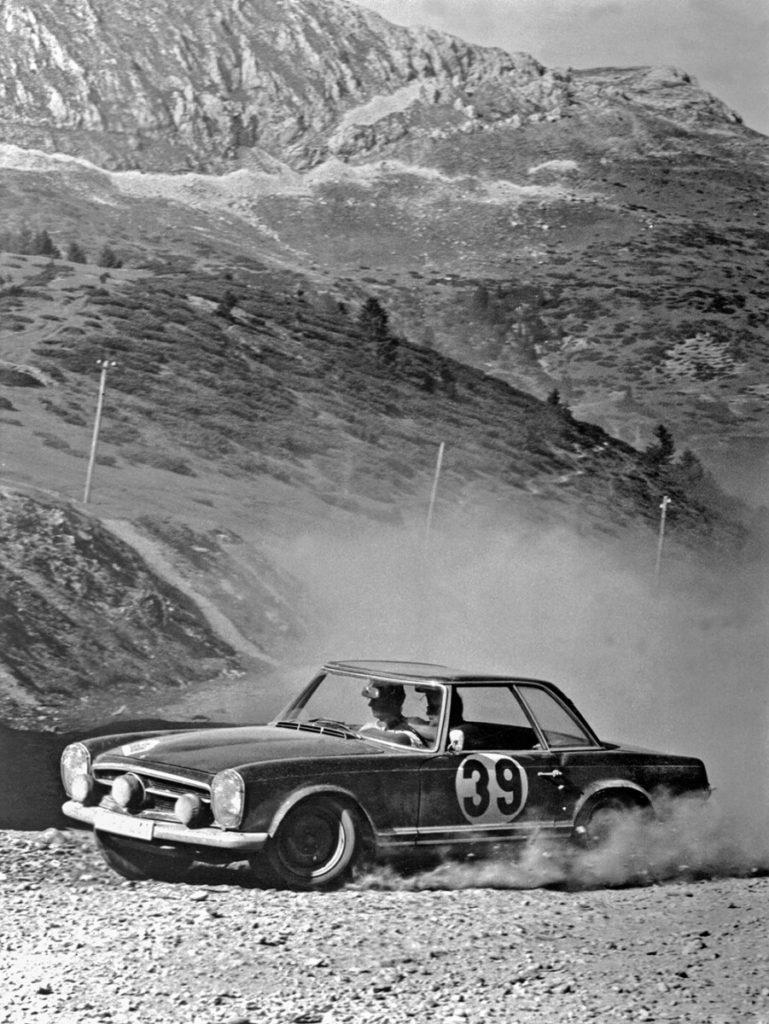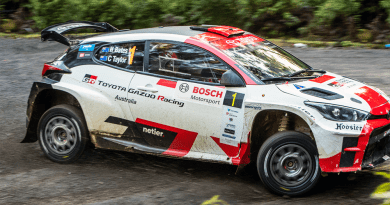Remembered: Eugen Böhringer, Mercedes-Benz works driver
100 years ago, last week (22 January 1922), Eugen Böhringer was born on the Rotenberg near Stuttgart. In addition to being a chef and hotelier, long-distance rallies were his speciality: for example, Böhringer won the the Liège-Sofia-Liège in 1962 and 1963. The Mercedes-Benz works driver also won one of the fastest rallies in the world, the Argentinian Touring Grand Prix, in 1963 and 1964. The 1962 European Rally Champion also finished second in the legendary Rally Monte Carlo three times and was a fast touring car driver.
Böhringer’s motorsport career was short, but successful. He was well over 30 years of age when he first competed in national rallies in the late 1950s, driving his private Mercedes-Benz 219 (W 105). His parents instilled in him an early enthusiasm for cars after buying the family a Mercedes 16/45 hp in 1925. Emma Böhringer, his mother, also drove the car, and was one of the first women in the Stuttgart area to have a driving licence. Taking apart and assembling toy cars made of sheet metal was one of her son’s favourite pastimes and he set his sights on an apprenticeship as an automobile mechanic.
Things turned out differently; an apprenticeship as a chef positioned him to take over the family-owned restaurant and hotel in Stuttgart-Rotenberg. As far as his schedule allowed, he attended racing events.
The step into motor racing goes back to a bet: The innkeeper won a few bottles of wine from regulars in his restaurant after he became the class winner in a skills tournament organised by the Untertürkheim Automobile Club. The talented driver then competed in smaller, local races before making his mark at the Solitude Rally in 1958 and 1959, with a second and first place.
These achievements were noticed by the Mercedes-Benz rally department, which signed him as a works driver for the 1960 season. In January that year, Böhringer/Hermann Socher finished second in the Mercedes-Benz 220 SE (W 111) at the Rally Monte Carlo behind teammates Walter Schock/Rolf Moll. In 1961, Böhringer achieved second place in the European Rally Championship with Rauno Aaltonen, who later won the Rally Monte Carlo. Because the Finn was faster on gravel, and the German faster on asphalt, the two sometimes changed places behind the wheel while the car was moving during a special stage. In 1962, Böhringer became European Rally Champion with co-drivers Peter Lang and Hermann Eger in a 220 SE. Successes for the year included victories in the Acropolis Rally and second place in the Rally Monte Carlo.
In 1962 and 1963, Böhringer won what Mercedes-Benz says was probably the toughest of all rallies, the Liège-Sofia-Liège marathon drive, with the Mercedes-Benz 220 SE and 230 SL (W 113). By today’s standards, the hardships are hardly imaginable. The route covered more than 5,000 kilometres on often unpaved roads through Germany, Austria, Italy, Yugoslavia, Romania and Bulgaria, including the crossing of numerous challenging Alpine passes. There were no breaks, only at the Sofia turnaround did the engines stop for 60 minutes. Only on the few unspectacular stretches of road (as noted by the roadbook), did the drivers and co-drivers take turns to sit in the right-hand seat for 15 or 20 minutes of sleep.
After the two victories, Böhringer/Klaus Kaiser finished third in the last edition of this classic event in 1964 with the 230 SL (W 113). They missed a third win in a row, due to the time lost to a defective alternator and two punctured tyres. Additionally, a sheep ran in front of their car, so they had to drive for two nights with only one headlamp. In Issue 22/1964 about this rally, magazine Kristall called their story The agony of 90 hours, because “for 90 eternal hours on this rally, any mistake can mean the end”. At best, one fifth of the starting field reached the finish. Böhringer remarked dryly: “You just have to step on the gas and brake little.”
The Argentinian Touring Grand Prix also covered around 5,000 kilometres but was divided into several stages. Böhringer and Kaiser won in 1963 and 1964 with the Mercedes-Benz 300 SE (W 112) ahead of their teammates, Dieter Glemser and Martin Braungart. Böhringer invented a special principle of pace notes for these teams. Curves are not divided into numbers from 1 to 10, but characterised, for example, from “right bend left” to a “fast left”.
Böhringer insisted on perfect preparation. While his teammates retired to their hotel rooms after long days of training, he sometimes said to his co-driver: “Come on, Klaus, we’re going out on the route again to check our write-up.” The performance-enhanced ‘tail fin’ Mercedes-Benz reached speeds of around 220 km/h. Long and straight asphalt sections allowed for very high speeds. In 1964, Böhringer/Kaiser won the first stage over 781.5 kilometres from Pilar to Carlos Paz in 4:19.25 hours. The average speed was 181 km/h. After this stage, race director, Karl Kling, ordered them to take it easy so as not to endanger the Mercedes-Benz 1-2-3 victory of Böhringer, Glemser and Ewy von Korff-Rosqvist.
Böhringer was also fast in circuit races. In 1964 he won the grand prix for touring cars at the Nürburgring with Dieter Glemser. Victories at Brands Hatch, Zolder, Karlskoga and Karlskoga were added to the list. Böhringer/Glemser lost the 24 Hours of Spa-Francorchamps due to a broken wheel hub after holding a clear lead shortly before the end of the race.
Mercedes-Benz shut down the rally department at the end of 1964. Böhringer started only once more. In one of the snowiest editions of the Rally Monte Carlo, he finished second in 1965 with co-driver, Rolf Wütherich, in a Porsche 904 Carrera GTS Coupé entered by the factory.
After a little more than five years in international rallying, Böhringer ended his career and concentrated on the restaurant and hotel business. He remained committed to his sport; at the 1971 Stuttgart-Charbonnières Rally, Böhringer noted the road conditions for his former teammates, Glemser and Kaiser, contributing to their third place overall.
Böhringer died in Stuttgart in the early hours of 19 June 2013 at the age of 91.
PHOTOS: MERCEDES-BENZ

The 29th Rally Monte Carlo – 18 to 24 January 1960. Eugen Böhringer with the Mercedes-Benz type 220 SE rally car (W 111). 
Mercedes-Benz rally driver, Eugen Böhringer. 
The 21st Coupe des Alpes – 27 to 30 June 1960. Eugen Böhringer/
Hermann Socher, Mercedes-Benz 220 SE rally car (W 111).
15 October 1961, Eugen Böhringer wins the 2nd Schorndorf Hill Climb Race for the Gottlieb Daimler Hill Climb Prize with a Mercedes-Benz 300 SL Roadster (W 198). 
The 32nd Liège-Sofia-Liège Rally from 29 August to 2 September 1962, Eugen Böhringer and Hermann Eger, Mercedes-Benz 220 SE rally car (W 111). 
The 33rd Liège-Sofia-Liège Rally from 27 to 31 August 1963, Eugen Böhringer/Klaus Kaiser, Mercedes-Benz 230 SL rally car (W 113) during a passage on scree trails in the karst landscape of Titograd, Yugoslavia. 
The 7th Argentinian Touring Grand Prix from 23 October to 2 November 1963, Eugen Böhringer/Klaus Kaiser, Mercedes-Benz 300 SE rally car (W 112). A pigeon crashed through the windscreen while the car was travelling at more than 200 km/h. In the subsequent rollover, Böhringer and Kaiser were uninjured thanks to seat belts. The incident did not prevent their victory with the 300 SE. 
Eugen Böhringer during a driver change at the Spa-Francorchamps 24-hour race on 25 and 26 July 1964. 
The 34th Spa-Sofia-Liège Rally from 25 to 29 August 1964, Eugen Böhringer and Klaus Kaiser, Mercedes-Benz 230 SL rally car (W 113). 
The 34th Spa-Sofia-Liège Rally from 25 to 29 August 1964. From left to right: Martin Braungart, Dieter Glemser, Alfred Kling, Ewy von Korff-Rosqvist, Manfred Schiek, Eugen Böhringer, Rolf Kreder and Klaus Kaiser. 
The 8th Argentinian Touring Grand Prix from 28 October to 7 November 1964. Eugen Böhringer/Klaus Kaiser win with a Mercedes-Benz 300 SE rally car (W 112).














